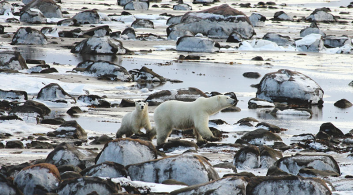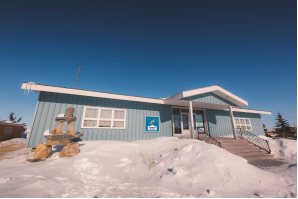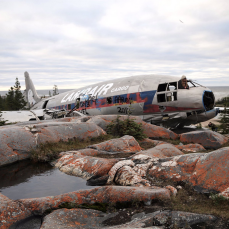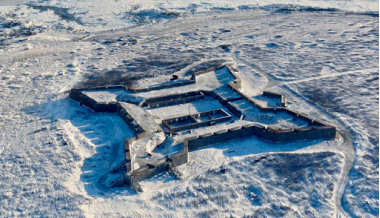Churchill, Manitoba 作者: 来源: 发布时间:2021-12-06
I.Population and Area
-Area
Land: 53.96 km2 (20.83 sq mi)
-Population (2016)
Total: 899
Density:16.7/km2 (43/sq mi)

II.Natural Geography (environment and resources)
![]()
-Churchill is a town in northern Manitoba, Canada, on the west shore of Hudson Bay, roughly 110 kilometres (68 miles) from the Manitoba–Nunavut border. It is most famous for the many polar bears that move toward the shore from inland in the autumn, leading to the nickname "Polar Bear Capital of the World" that has helped its growing tourism industry.
-Churchill is located on Hudson Bay, at the mouth of the Churchill River on the 58th parallel north, far above most Canadian populated areas. Churchill is far from any other towns or cities, with Thompson, approximately 400 km (250 mi) to the south, being the closest larger settlement. Manitoba's provincial capital, Winnipeg, is approximately 1,000 km (620 mi) south of Churchill.
III.ECONOMY
-The average salary for jobs in Churchill, Manitoba is $52,981 (CAD) per year or an hourly rate of $25 (CAD).
-Website: https://www.salaryexpert.com/salary/area/canada/manitoba/churchill
IV.Industrial Characteristics
-Tourism and ecotourism are major contributors to the local economy, with the polar bear season (October and November) being the largest. Tourists also visit to watch beluga whales in the Churchill River in June and July. The area is also popular for birdwatchers and to view the aurora borealis.
-The Port of Churchill is the terminus for the Hudson Bay Railway operated by the Arctic Gateway Group. The port facilities handle shipments of grain and other commodities around the world. The Churchill Northern Studies Centre also attracts visitors and academics from around the world interested in sub-Arctic and Arctic research. The town also has a health centre, several hotels, tour operators, and restaurants, to serve locals and visitors.
-Ecotourism
Churchill is situated along Manitoba's 1,400 km (870 mi) coastline, on Hudson Bay at the meeting of three major biomes: marine, boreal forest and tundra, each supporting a variety of flora and fauna. Each year, 10,000–12,000 eco-tourists visit, about 400–500 of whom are birders.
-Polar bears
-Polar bears were once thought to be solitary animals that would avoid contact with other bears except for mating. In the Churchill region, however, many alliances between bears are made in the fall. These friendships last only until the ice forms, then it is every bear for itself to hunt ringed seals. Starting in the 1980s, the town developed a sizable tourism industry focused on the migration habits of the polar bear. Tourists can safely view polar bears from specially modified vehicles built to navigate the tundra terrain. Utilizing a set of trails created by the Canadian and US military, responsible tour operators are granted permits to access these trails for wildlife viewing. Staying on these established trails ensures no further damage is done to the tundra ecosystem. October and early November are the most feasible times to see polar bears, thousands of which wait on the vast peninsula until the water freezes on Hudson Bay so they can return to hunt their primary food source, ringed seals. There are also opportunities to see polar bears in the non-winter months, with tours via boat visiting the coastal areas where polar bears can be found both on land and swimming in the sea.
Many locals even leave their cars unlocked in case someone needs to make a quick escape from the polar bears in the area. Local authorities maintain a so-called "polar bear jail" where bears (mostly adolescents) who persistently loiter in or close to town, are held after being tranquilised, pending release back into the wild when the bay freezes over. It is the subject of a poem, Churchill Bear Jail, by Salish Chief Victor A. Charlo.
-Beluga whales
Thousands of beluga whales, which move into the warmer waters of the Churchill River estuary during July and August to calf, are a major summer attraction. Polar bears are present as well, and can sometimes be seen from boat tours at this time of year.
-Birds
Churchill is also a destination for bird watchers from late May until August. Birders have recorded more than 270 species within a 25 mi (40 km) radius of Churchill, including snowy owl, tundra swan, American golden plover and gyrfalcon. Plus, more than 100 birds, including parasitic jaeger, Smith's longspur, stilt sandpiper, and Harris's sparrow, nest there.
V.Attractions
1.Itsanitaq Museum

-Itsanitaq Museum has a collection of Inuit carvings and artifacts that are among the finest and oldest in the world dating from Pre-Dorset (1700 B.C.) through Dorset, Thule and modern Inuit times. Manitoba Heritage Council plaques commemorate the presence of Pre-Dorset and Dorset peoples who lived in this area from 3000 to 1000 B.C. The gift shop specializes in northern books, Canadian Inuit art, unique postcards, art cards, stationery and local wildberry preserves.
-Open year-round, in summer, Monday, 1 p.m.- 5 p.m., Tuesday to Saturday, 9 a.m.- noon and 1 p.m.- 5 p.m.; in winter, Monday to Saturday, 1 p.m.- 4:30 p.m.; closed Sundays and holidays. Groups of 10 or more by advance reservation. Donations accepted.
-Tel. 204-675-2030
-Fax: 204-675-2140
-Website: https://www.travelmanitoba.com/listings/itsanitaq-museum/555/
2.Miss Piggy plane wreck

-This is the wreck of a Curtiss C-46 “Commando” twin-prop cargo aircraft owned by Lamb Airways Ltd. Widely used by the US military during the Second World War, the plane crashed at 9:30 AM on 13 November 1979 as it attempted to return to the Churchill airport shortly after takeoff, after the pilot reported mechanical problems with one of its engines. The plane landed in rough terrain and was badly damaged. Three crew members were slightly injured in the crash.
-Website: http://www.mhs.mb.ca/docs/sites/misspiggy.shtml
3.The Prince of Wales Fort

-The Prince of Wales Fort is a historic bastion fort on Hudson Bay across the Churchill River from Churchill, Manitoba, Canada.
-The European history of this area starts with Henry Hudson sailing into Hudson Bay in 1610. The area was recognized as important in the fur trade and of potential importance for other discoveries. The fort is built in a star shape.
-Original (wood) fort
This fort began as a log fort built in 1717 by James Knight of the Hudson's Bay Company (HBC) and was originally called the Churchill River Post. In 1719, the post was renamed Prince of Wales Fort. It was located on the west bank of the Churchill river to protect and control the Hudson's Bay Company's interests in the fur trade.
-Construction of the present stone fort
The original wooden fort was replaced by a massive stone fort, probably to abide by the Royal Charter which required that Rupert's Land should be fortified.
Construction of this fort, a structure still standing today, was started in 1731 near what was then called Eskimo Point. It was in the form of a square, with sides 90 m (300 ft) long and walls 6 m (20 ft) tall and 9 m (30 ft) thick at the base.
It had forty-two cannons mounted on the walls. There was also a battery across the river on Cape Merry meant to hold six more cannons.
Work on the fort continued almost without break until 1771, but it was never truly completed.
-In battle
In the 1780s, the French government launched a Hudson Bay expedition to damage HBC activities in that bay. Three French warships of the expedition, led by Jean-François de La Pérouse, captured the Prince of Wales Fort in 1782. The fort was manned by only 39 (non-military) men at the time, and the fort's Governor, Samuel Hearne, recognised the numerical and military imbalance and surrendered without a single shot being fired. The French partially destroyed the fort, but its mostly-intact ruins survive to this day.
The fort returned to the HBC in 1783. Thereafter, its importance waned with the decline in the fur trade although the post was refounded a little way up the river.
Address: Prince of Wales Fort, Churchill, MB R0B 0E0
-Phone: (204) 675-8863
-Website: https://www.pc.gc.ca/en/lhn-nhs/mb/prince
VI.History
-A variety of nomadic Arctic people lived and hunted in this region. The Thule people arrived around the year 1000 from the west, the ancestors of the present-day Inuit. The Dene people arrived around the year 500 from farther north. Since before the time of European contact, the region around Churchill has been predominantly inhabited by the Chipewyan and Cree natives.
-Europeans first arrived in the area in 1619 when a Danish expedition led by Jens Munk wintered near where Churchill would later stand. Only 3 of 64 expedition members survived the winter and sailed one of the expedition's two ships, the sloop Lamprey, back to Denmark. Danish archaeologists in 1964 discovered remains of the abandoned ship, the Unicorn (a frigate), in the tidal flats some kilometres from the mouth of the river. The discoveries were all taken to Denmark; some are on display at the National Museum in Copenhagen.
-After an abortive attempt in 1688–89, in 1717 the Hudson's Bay Company built the first permanent settlement, Churchill River Post, a log fort a few kilometres upstream from the mouth of the Churchill River. The trading post and river were named after John Churchill, 1st Duke of Marlborough (an ancestor of Winston Churchill), who was governor of the Hudson's Bay Company in the late 17th century. The fort was built mostly to capitalize on the North American fur trade, out of the reach of York Factory. It dealt mainly with the Chipewyan natives living north of the boreal forest. Much of the fur came from as far away as Lake Athabasca and the Rocky Mountains.
-As part of the Anglo-French dispute for North America, in 1731–1741 the original fort was replaced with Prince of Wales Fort, a large stone fort on the western peninsula at the mouth of the river. In 1782, the French, led by La Pérouse, captured it. Since the British, under Samuel Hearne, were greatly outnumbered and in any event were not soldiers, they surrendered without firing a shot. The leaders agreed Hearne would be released and given safe passage to England, along with 31 British civilians, in the sloop Severn, on condition he immediately publish his story "A Journey to the Northern Ocean". In return, the British promised the same number of French prisoners would be released and a British navigator familiar with the waters safely conduct the French from Hudson's Bay at a time of year when the French risked becoming trapped in winter ice. The French made an unsuccessful attempt to demolish the fort. The worst effect was on the natives, who had become dependent on trade goods from the fort, and many of them starved. Extensive reconstruction and stabilization of the fort's remains have taken place since the 1950s.
-In 1783, Hearne returned to build a new fort, a short distance upriver. Due to its distance from areas of heavy competition between the North West Company and the Hudson's Bay Company, it remained a stable, if not profitable, source of furs.
-Between the years of decline in the fur trade and surfacing of western agricultural success, Churchill phased into and then back out of obsolescence. After decades of frustration over the monopoly and domination of the Canadian Pacific Railway, western Canadian governments banded together and argued for the creation of a major new northern shipping harbour on Hudson Bay, linked by rail from Winnipeg. Initially Port Nelson was selected for this purpose in 1912. After several years of effort and millions of dollars, this project was abandoned and Churchill was selected as the alternative after World War One. Surveys by the Canadian Hydrographic Service ship CSS Acadia opened the way for safe navigation. However, construction and use of the railroad was extremely slow and the rail line itself did not come to Churchill until 1929.
-Once the link from farm to port was completed, commercial shipping took many more years to pick up. In 1932 Grant MacEwan was the first person to cross through Churchill customs as a passenger. This was purely due to his determination in taking the Hudson Bay route to Saskatchewan from Britain—most passengers returned via the Saint Lawrence River.
-In 1942, the United States Army Air Forces established a base called Fort Churchill, 8 km (5 mi) east of the town. After World War II, the base served several other purposes including as a Strategic Air Command facility. Following the demolition of the base it was repurposed into the town's airport.
-Naval Radio Station Churchill, callsign CFL, was activated as an ionospheric study station by the RCN in support of the U-boat HFDF net and became operational on August 1, 1943. Around 1949, Churchill became part of the Canadian SUPRAD (signals intelligence) network and remained in that role until it closed its doors in 1968. The Operations and Accommodations building remains today but is abandoned.
-This area was also the site of the Churchill Rocket Research Range, part of Canadian-American atmospheric research. Its first rocket was launched in 1956, and it continued to host launches for research until closing in 1984. The site of the former rocket range now hosts the Churchill Northern Studies Centre, a facility for multidisciplinary Arctic research.
-In the 1950s, the British government considered establishing a site near Churchill for testing their early nuclear weapons, before choosing Australia instead.
VII.Other information
-As of the 2016 Canada Census, just over two-thirds (67%) of the population is Indigenous and the rest (23%) are non-native. A large number of residents are Chipewyan and Swampy Cree (43.9%), with some Métis (18.6%) and a small number of Inuit (4.5%).
-The non-native population is largely of European descent, although a small number of Black Canadians (2.3%) and Latin Americans (1%) also reside in Churchill.
-Hunting, trapping and fishing is still an important activity to most of these residents. Although there are some summer trails, snowmobiles are their main transport in the winter.
-English is the most commonly spoken language, followed by Cree, Inuktitut, French and Dene.
-The town has a modern multiplex centre housing a cinema, cafeteria, public library, hospital, health centre, day care, swimming pool, ice hockey rink, indoor playground, gym, curling rinks and basketball courts. Nearby is the "Eskimo Museum", operated by the Diocese of Churchill-Baie d'Hudson, with over 850 high quality Inuit carvings on permanent display. The exhibits include historic and contemporary sculptures of stone, bone, and ivory, as well as archaeological and wildlife specimens. The Parks Canada visitor centre also has artifacts on display and makes use of audiovisual presentations of various topics involving the region's natural and archaeological history.
-By the late 1980s, both the local government and Parks Canada had successfully educated its population on polar bear safety, significantly reducing lethal confrontations and fueling ecotourism such that both the community and the polar bears benefited.
VIII.Contact information
-Government
Type: Town Council
Mayor: Michael Spence
-TOWN OF CHURCHILL
Location: PO Box 459, Churchill, Manitoba R0B 0E0
TEL: (204) 675-8871
Roll Free: (204) 675-2934
Email: townofchurchill@churchill.ca
-Website: http://www.churchill.ca/
